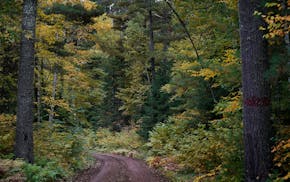CLITHERALL, Minn. – Minnesota has a significant milestone this year that nobody is really talking about: the first official sighting of the Asian lady beetle in our state.
It was 1994, 30 years ago, when scientist John Luhman was making his way into the entomology building on the University of Minnesota's St. Paul campus and noticed an unusual beetle clinging to the brick.
"It wasn't any of my usual suspects because it was too large and had too many spots, and it was the wrong color," said Luhman, who, as a biocontrol specialist and insect taxonomist, was possibly the best person to encounter it. "Right away, I knew it was something new."
He carried it into the building and soon identified it as Harmonia axyridis, or the Asian lady beetle, an invasive species that had been brought from Asia to the U.S. in the late 1970s or early 1980s to protect Georgia pecan trees from aphids. In Minnesota, it consumed the larvae of native ladybugs, and the native species' numbers dwindled, said Luhman, who is now retired.
If you live in a big city surrounded by homes and offices, you might not notice the Asian lady beetle. But in many rural parts of the state, it has become a scourge.
My own introduction to the Asian lady beetle was in 2012 after returning home to our Otter Tail County farmhouse with our newborn son and a fresh C-section scar.
There must have been tens of thousands of them in our house that winter. As I lay on the couch with our baby that first night, my mother-in-law and my husband vacuumed up as many as they could from ceilings and walls and furniture. By the next night, others had replaced them. As soon as I healed, I began vacuuming like a warrior queen, sucking up hundreds of them every morning and hundreds more every night. Still, they would race around our light fixtures, leaving a brownish trail, congregate by the water faucets, hide under the dish drain and behind pictures on the wall.
They can be found in greater Minnesota wherever soybean fields are found. They're great for farmers and gardeners because they eat the aphids that damage plants and reduce yields. But many a beautiful fall walk has been ruined by drifting clouds of the beetles landing on your hair and glasses, and sometimes delivering what feels like a bite. It's actually not, Luhman said. They want to drink the moisture from your skin, but their sharp proboscis gets in the way and pokes you like a teensy ice pick.
They don't tend to swarm on cloudy, cool days, just the last lovely, sunny days of autumn, exactly when Otter Tail County visitors want to climb Inspiration Peak to view the fall colors or go on a peaceful hike.
Some people in greater Minnesota might never notice them. Kelsey Hill, office manager for Detroit Lakes Pest Control, said she doesn't see Asian lady beetles south of Detroit Lakes, where she lives, but they're bad in nearby Frazee.
Bridget Dawley, office manager for pest control company IPC, said she might see only one or two Asian lady beetles in her downtown Mankato office, but the area around New Richland, Ellendale, Heartland, New Ulm and Sleepy Eye gets inundated.
"It's rural, really, is what it is," she said. "When you're surrounded by cornfields or soybean fields, they're going to cover your house where the sun shines."
Asian lady beetles are considered biological controls, a fancy way of saying organisms brought in to control undesirable organisms, such as aphids.
When the Asian lady beetle was introduced, it was easier to bring biological controls into the U.S. than it is today, said University of Minnesota entomologist Bill Hutchison.
Partly because of debacles like the Asian lady beetle, the federal government began changing its policies about 15 to 20 years ago, he said, requiring new species to undergo up to a decade of testing to prevent unintended consequences.
"They've made it much more difficult to actually bring in new species," he said. "So that is a change that's occurred for the better."
The Asian lady beetle would never have passed the new standards, he said.
Asian lady beetles save farmers from using as much pesticide, but those costs, and toxicity, have transferred to everyone who hires a company to spray their house each fall.
So, 30 years, Asian lady beetles! Let's strike up the oompah band! Or at least the out-of-tune trombones.

Tolkkinen: Fergus Falls priest who studied with Pope Leo says he has good hearing 'to hear everyone'

Tolkkinen: Just when I was starting to lose myself in nature's grandeur, along came a motorcycle

Tolkkinen: On a three-day northern Minnesota tour, the grit and glory of our state became clear

Tolkkinen: Brainerd City Council should spend a night, or 30, sleeping outdoors


